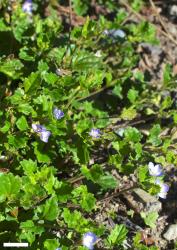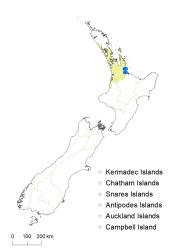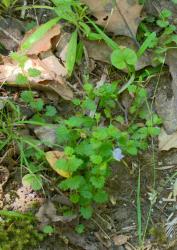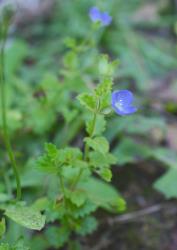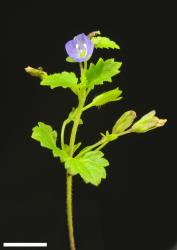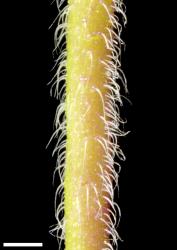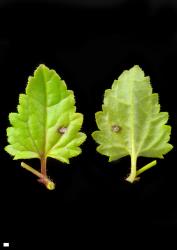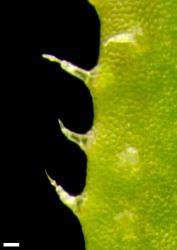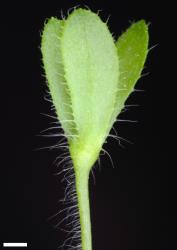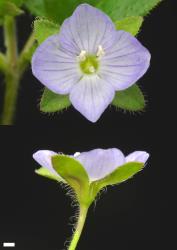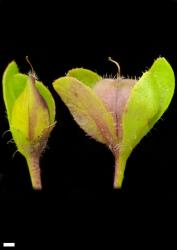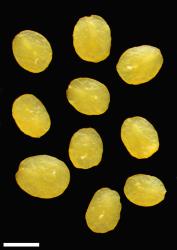Perennial herb, or sometimes softly woody at base, to 0.15 m tall. Stems prostrate to ascending, stoloniferous, pubescent, hairs bifarious, or sometimes uniform. Leaf bud indistinct; leaves separating while small, opposite-decussate, erecto-patent to spreading; lamina thin, deltoid, broadly ovate, or sub-orbicular, 4–15 mm long, 3–20 mm wide, dull green above, paler and sometimes pinkish beneath; veins palmate, 3–5 from base; surfaces with scattered tapering eglandular hairs above and beneath, especially along veins beneath; margin sparsely ciliate, serrate-dentate; teeth in 3–6 pairs; apex acute or sub-acute; base usually truncate, sometimes weakly sub-cordate or abruptly cuneate; petiole 2–15 mm long. Inflorescence a lateral raceme, 3–8 mm long, or sometimes a solitary bibracteate flower; flowers distant, 2–8 per inflorescence, all bisexual; bracts alternate or sub-opposite, oblanceolate to spathulate, < pedicels; pedicels erect at flowering, spreading to reflexed at fruiting, 2–13 mm long, with 1 row of long, slender hairs. Calyx lobes 4, sub-acute to obtuse, 4.0–4.5 mm long at flowering, 6–7 mm long at fruiting, equal to sub-equal, glabrous on faces, ciliate on margins with mostly long, slender hairs. Corolla 7–10 mm diameter; tube white, 0.5 mm long, < calyx, hairy within; lobes 4, pale blue, spreading, unequal, orbicular or elliptic, 5–7 mm long, rounded; nectar guides dark blue. Stamen filaments white 2.5–3.0 mm long, anthers white. Style glabrous, 1.8–2.2 mm long. Capsules angustiseptate, shallowly emarginate, glabrous on faces, ciliate on margins, 4.0–5.2 mm long, 4–5 mm at widest point. Seeds ellipsoid, flattened, smooth, straw-yellow to pale brown, 1.2–1.5 mm long.
V. calycina is most likely to be confused with V. plebeia. The inflorescence hairs on V. calycina plants are in single rows and the single row of long hairs on the pedicel is particularly distinctive, whereas in V. plebeia plants the hairs are shorter and all around the rachis and pedicels. When not flowering the most distinctive feature to distinguish V. plebeia from V. calycina plants is the presence of very short hairs on stems and leaf margins of V. plebeia, even though longer hairs are also present on the leaves (shortest hairs < 0.4 mm compared with 0.5–1.0 mm for V. calycina). V. plebeia plants have a similar creeping habit, but also differ from V. calycina plants in having sharper leaf teeth, some of the hairs very short on stems and among longer hairs on leaves, calyx margins and capsules, smaller corollas not exceeding the calyx lobes, purplish red stigmas, and smaller capsules and seeds. The cells of the longer hairs of V. calycina tend not to collapse on drying, or sometimes they slightly collapse orthogonally to adjacent cells.
Plants of the native V. jovellanoides, known from only one locality, have a similar creeping habit, but differ in having glandular (among the eglandular) hairs on the inflorescence, larger and white corolla with magenta nectar guides, longer stamens (4.0–4.5 mm) and style (3.5–4.0 mm), and larger capsules.
| calycina | plebeia |
Stem hairs | ≥ 1 mm long | < 0.4 mm long; a few long ones at nodes |
Leaf hairs | all long, tapering from broad base, especially on veins beneath, near margin above, and a few on petiole (very short hairs absent) | both short and long: short scabrid hairs dense near margins above (looking marginal because margin is in-rolled) and along petiole; long hairs tapering from swollen base, especially on veins beneath |
Pedicel hairs | long, in one row | very short, all around |
Calyx lobes (mm) | 4–4.5 mm at flowering; 6–7 mm at fruiting | 2–3 mm at flowering; 5–6 mm at fruiting |
Calyx lobes | usually narrowly elliptic, sometimes oblanceolate | oblanceolate to spathulate |
Calyx hairs | lobes long ciliate | lobes with minute scabrid hairs on margins and longer ones on faces |
Corolla diameter | 7–10 mm | 4–6 mm |
Style | 1.8–2.2 mm long, glabrous, not swollen at base | 0.8–1.5 mm long, glabrous to sparsely bristly, distinctly swollen at base (for about 0.1 mm) |
Stigma | white | purplish red |
Capsule | weakly emarginate; ciliate on margins, glabrous on faces; 4–5.2 × 4–5 mm | truncate to weakly emarginate; with scattered very short hairs on faces and margins, or glabrous; 2.5–4 × 2.5–4.5 mm |
Seeds | 1.2–1.5 mm long | 0.9–1.2 mm long |
North Island: Auckland (between Waihī Beach and Orokawa Bay; Kaimai Range near Aongatete).
Coastal, among grasses and sedges under Metrosideros excelsa and beside tracks in forest. Recorded elevations range from 9 to 250 m.
V. calycina was first collected (at Waihī) in 1906 and again several times since 2010 (near Waihī Beach and near Aongatete). It is well established now and might be a natural introduction from Australia, hence a native plant, or it could be an early naturalised species that has not spread far beyond the original introduction. In addition to its presence in New Zealand, V. calycina is indigenous to south-eastern Queensland, eastern New South Wales, Victoria, south-eastern South Australia, south-western Western Australia, and northern Tasmania.
de Lange et al. (2018, p. 6, 27, as indigenous). Voucher AK 310554, de Lange 8781 & de Lange, Orokawa Bay north of Waihī Beach.
Flowers: October–February; fruits: November–February.
Australian material has 2n = 36 (Briggs & Ehrendorfer 2006).
Veronica calycina is classified in V. subg. Pseudoveronica sect. Labiatoides (Albach et al. 2004; Albach & Meudt 2010). Albach & Briggs (2012) used nuclear and chloroplast DNA markers to place V. calycina with seven other species in the V. calycina clade, and it appears to be sister species to V. subtilis. If it is native, it appears to be a Veronica introduction that is independent of V. sect. Hebe and V. plebeia.
An earlier record of V. calycina R.Br. by Allan Cunningham (1836) is based on a specimen of V. plebeia. Nomenclaturally, that record is based on a misidentification, and the name is not a newly described later homonym.



